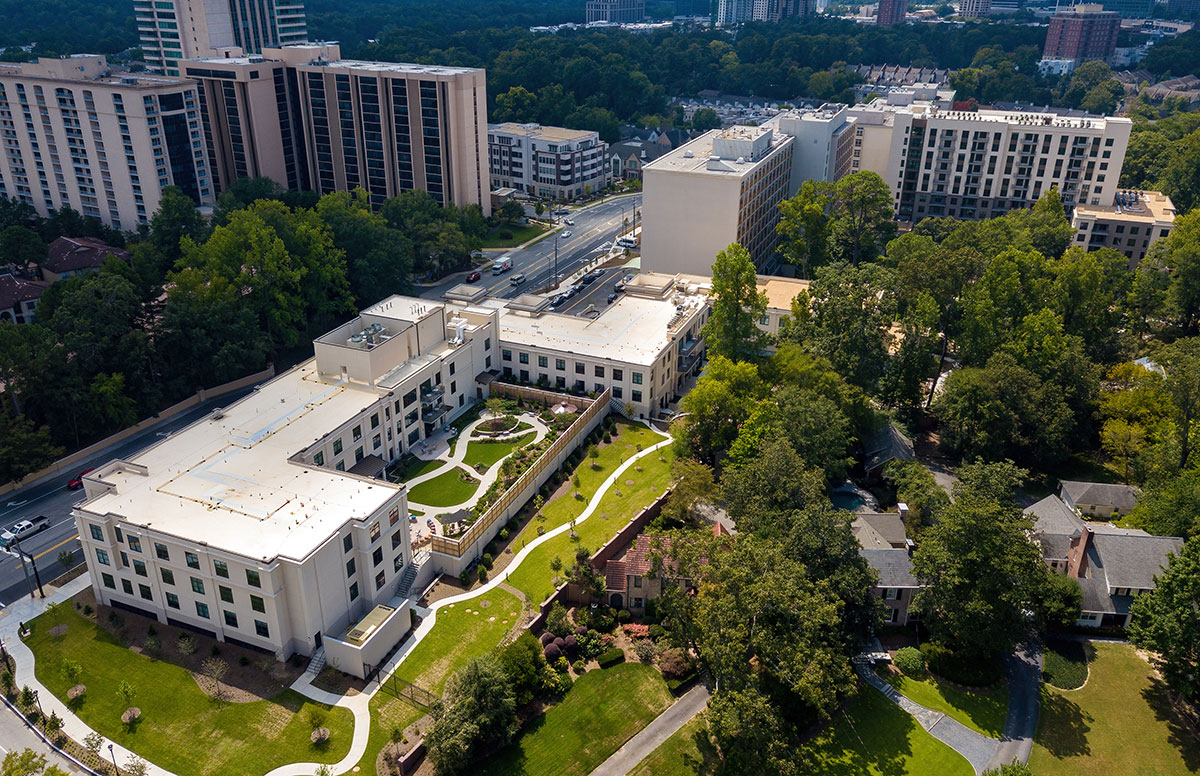While many life plan communities choose to grow through affiliation or merger, Atlanta’s first life plan community, Canterbury Court, is approaching its 60th birthday well-positioned to maintain its individuality and status as a single-site retirement community in the Buckhead district of the city. Canterbury Court President and CEO Debi McNeil explains the strategy of these campus updates—including paying close attention to consumer preferences.
LeadingAge: Construction on your “Enrichment Project,” which has roots in the mid-2010s, began in 2021. Major additions include the Monarch Pavilion, a new health care building housing skilled nursing, assisted living, and memory support, and the 10-story Garden Tower, Canterbury Court’s fourth independent living building. Nearly 20,000 square feet of campus green space has been added, including a memory garden at the Monarch Pavilion and a terrace adjacent to the Garden Tower. What was the impetus behind this project?
Debi McNeil: The first discussions at the board level about the need for dedicated memory care really started as early as 2013. One of the goals was to have state-of-the-art health care and memory care services. In our strategic analysis, led by senior living advisory firm Greystone in 2016, we determined that we could not just convert the existing [health] building to accomplish that; we needed to have additional construction. Our other strategic goals were to focus on wellness and to make investments in our facilities, technology, and human resources to advance our market position. We wanted to expand our services to seniors of lesser means and to develop community-based programs and services consistent with our faith-based roots.
LeadingAge: What kind of consumer research was done to help in the evaluation of the organization’s position?
Debi McNeil: We went to both our existing residents and the public to see what’s important to people, and what kind of things they wanted, then focused our efforts on being able to provide that when we designed our apartments. We looked at the apartment sizes, amenities, finishes, and the amenities on our campus. We opened our first bar, because that is certainly an amenity that people want! And while we always had a fitness center, we focused not just on traditional working out, but overall wellness and spiritual wellness.
LeadingAge: How has the Enrichment Project strengthened your position, given that you remain a single site?
Debi McNeil: We pretty much doubled the size of our campus; a substantial growth for us. We’re now at a much better size to have operating efficiencies and provide the amenities and services that our residents want, and what the market wants. As a faith-based and nonprofit life plan community, our services are well-known. We tend to attract individuals who have lived in the Atlanta area most of their lives. What we’re seeing is the growing number of adults who are moving to Atlanta to be closer to their children. When we started this project, I would have told you that 60-70% of our residents came from within a five-mile radius of our community. And that number is starting to shrink as we see more and more people coming in from out of town.
LeadingAge: How much fundraising was required?
Debi McNeil: The Enrichment Project was actually funded through bonds and equity, but at the same time, we ran a capital campaign to raise $7.5 million to enable us to expand our green space and to grow our ability to provide financial assistance to help residents be able to live at Canterbury Court. The capital campaign is now closed out, but we are focused on growing our resident assistance endowment through a planned giving society, focused on bequests, gifts of refundable entrance fees, gifts from IRAs, etc. By growing our resident assistance fund, we hope to make the Canterbury lifestyle and services we offer more available to the middle market [consumer].
LeadingAge: Can you elaborate on the “middle market” plan? Who is that designed for and what will it entail?
Debi McNeil: Individuals who had very critical careers that are crucial to our world and our economy, but don’t pay the type of salaries that can provide for this type of retirement, or people who were able to save but drained their resources on the health of a spouse or a family member. The goal is to help these individuals get into a life plan community, to benefit from the social engagement and personal growth with the security of knowing their future health needs will be met. It’s not necessarily expanding our product offering, but helping individuals who need a little support to be able to live at Canterbury Court. The model could subsidize up to 100% of an entrance fee or up to half of a monthly service fee on one- or two-bedroom apartments. It really will be dependent on how much money we can raise, but our ultimate goal is to see if up to 5% of our community could be subsidized in some capacity.
Photo: The Canterbury Court campus. The Monarch Pavilion (lower left), which houses skilled nursing, assisted living, and memory support, includes a 10,000 square-foot memory garden for memory care residents. The new 103-unit Garden Tower independent living building is in the upper right. Photo courtesy of Anstey Hodge.
How is your organization adapting to changing conditions and repositioning itself for the future? What are the considerations driving your expansion, affiliation, or service mix changes? Share your experiences and lessons learned with colleagues via the LeadingAge Story Collector, powered by Greystone, which makes it easy to submit your story. Try it now.

 Shutdown Week Three: Impact of Ongoing Closure on Affordable Housing
Shutdown Week Three: Impact of Ongoing Closure on Affordable Housing


